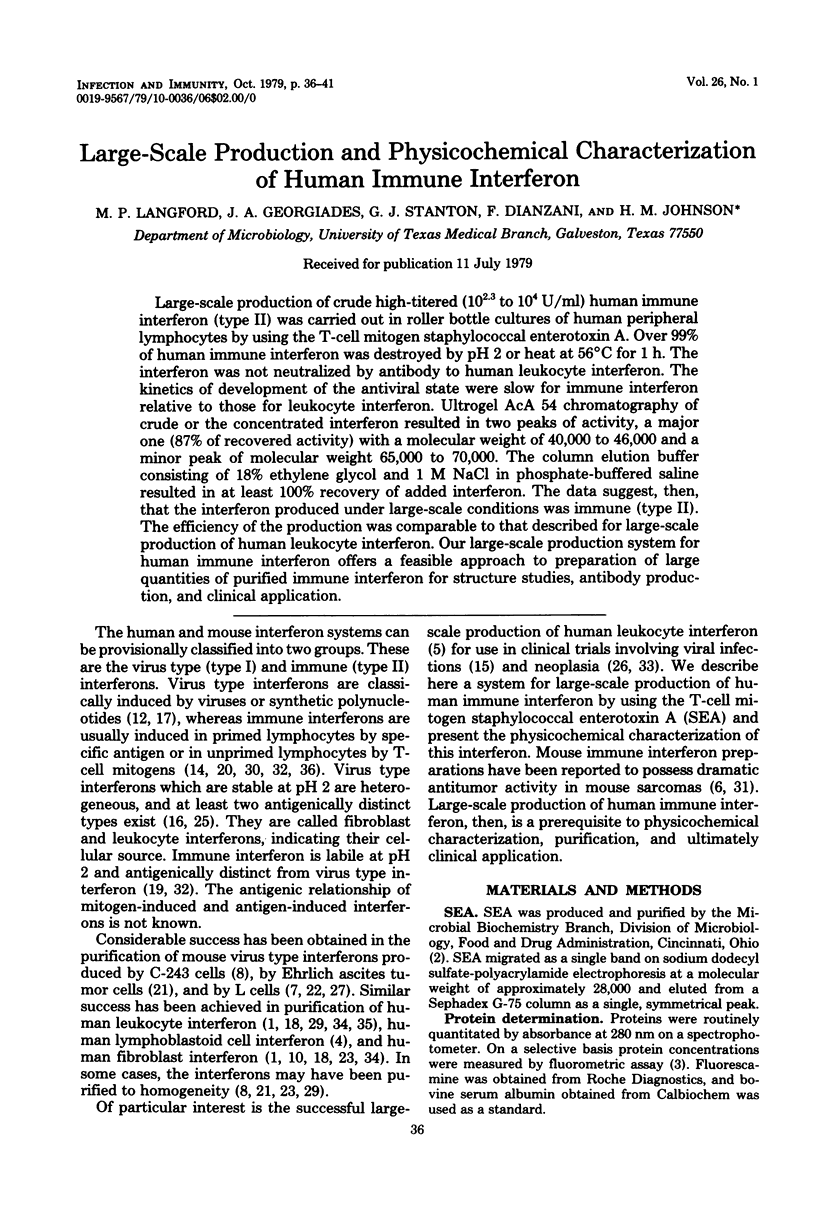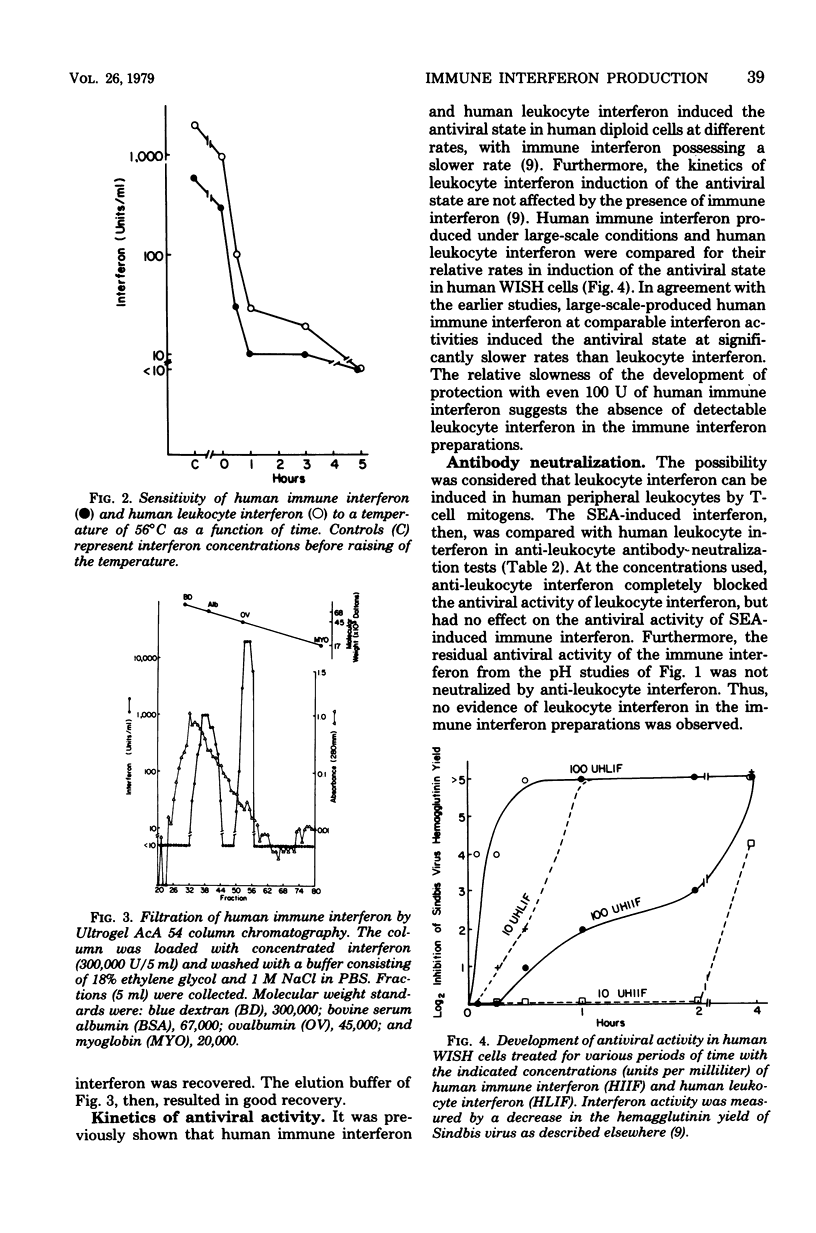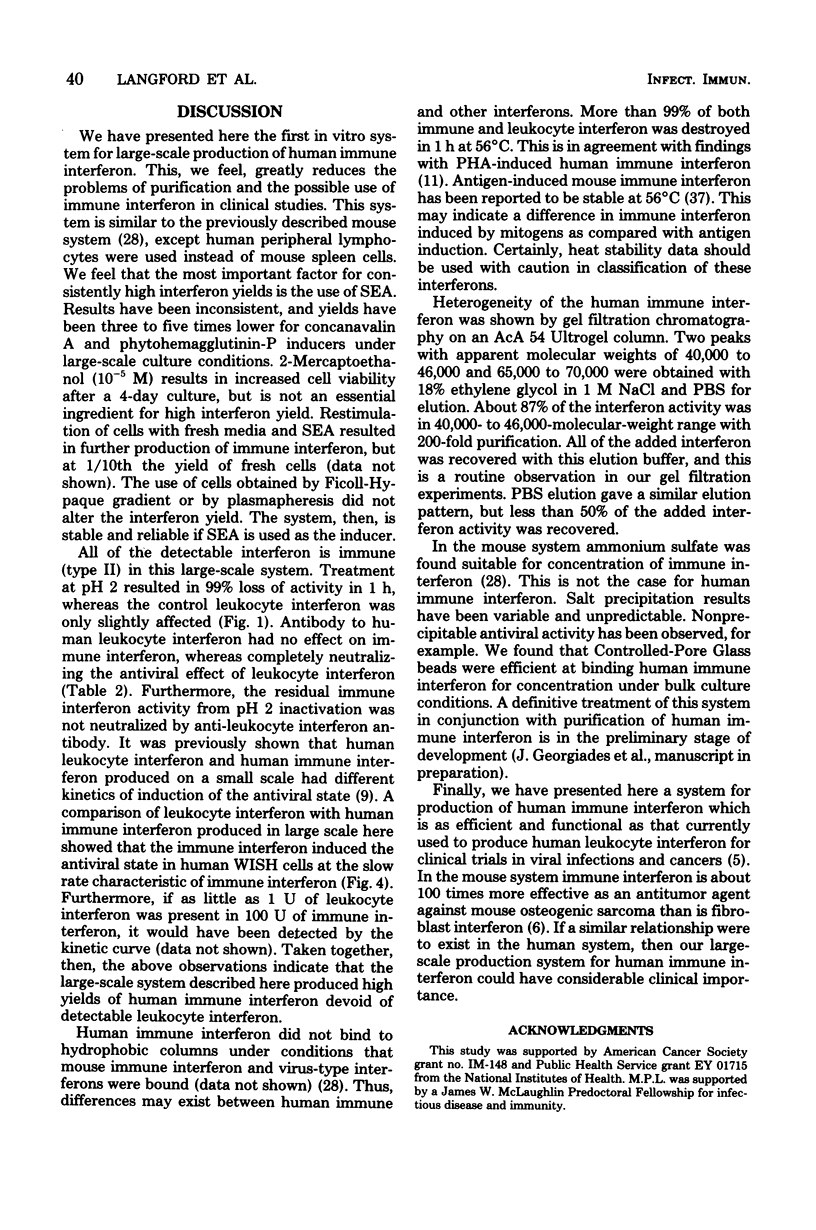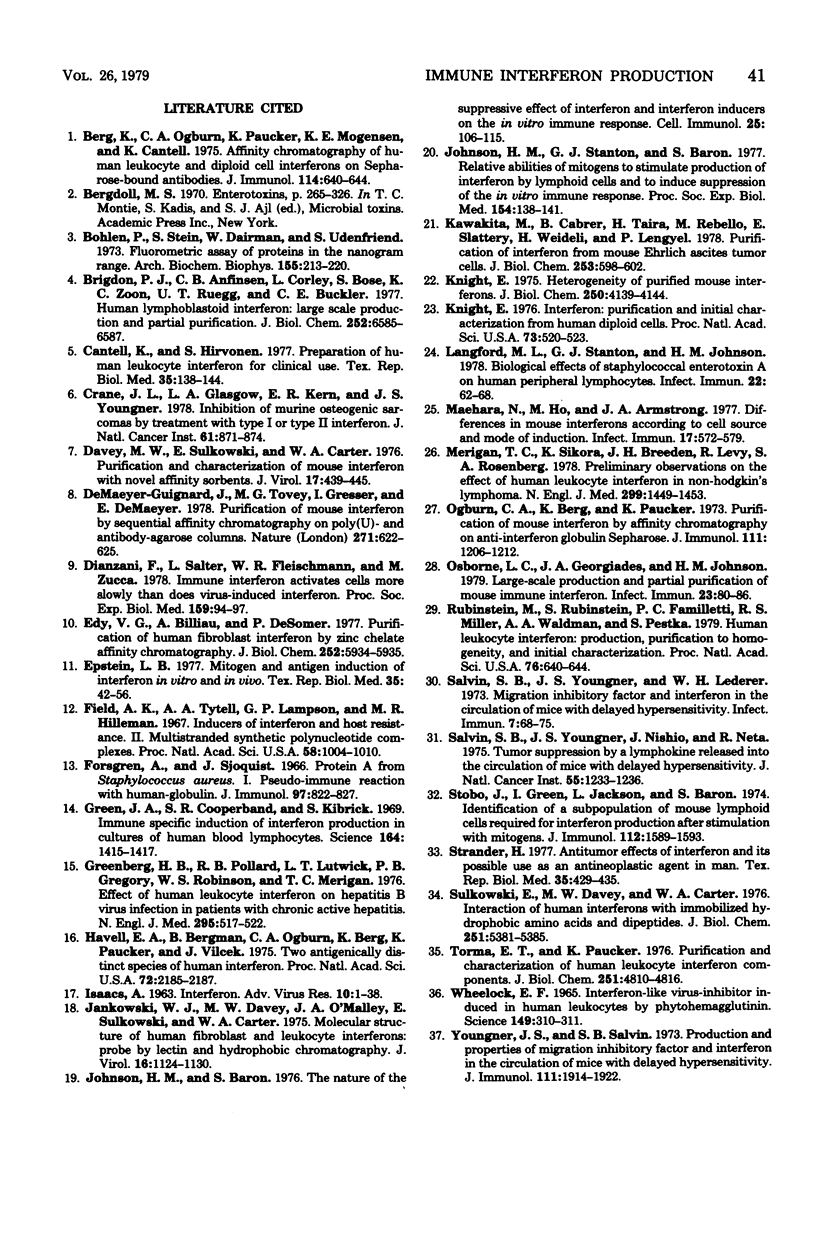Abstract
Large-scale production of crude high-titered (10(2.3) to 10(4) U/ml) human immune interferon (type II) was carried out in roller bottle cultures of human peripheral lymphocytes by using the T-cell mitogen staphylococcal enterotoxin A. Over 99% of human immune interferon was destroyed by pH 2 or heat at 56 degrees C for 1 h. The interferon was not neutralized by antibody to human leukocyte interferon. The kinetics of development of the antiviral state were slow for immune interferon relative to those for leukocyte interferon. Ultrogel AcA 54 chromatography of crude or the concentrated interferon resulted in two peaks of activity, a major one (87% of recovered activity) with a molecular weight of 40,000 to 46,000 and a minor peak of molecular weight 65,000 to 70,000. The column elution buffer consisting of 18% ethylene glycol and 1 M NaCl in phosphate-buffered saline resulted in at least 100% recovery of added interferon. The data suggest, then, that the interferon produced under large-scale conditions was immune (type II). The efficiency of the production was comparable to that described for large-scale production of human leukocyte interferon. Our large-scale production system for human immune interferon offers a feasible approach to preparation of large quantities of purified immune interferon for structure studies, antibody production, and clinical application.
Full text
PDF





Selected References
These references are in PubMed. This may not be the complete list of references from this article.
- Berg K., Ogburn C. A., Paucker K., Mogensen K. E., Cantell K. Affinity chromatography of human leukocyte and diploid cell interferons on sepharose-bound antibodies. J Immunol. 1975 Feb;114(2 Pt 1):640–644. [PubMed] [Google Scholar]
- Bridgen P. J., Anfinsen C. B., Corley L., Bose S., Zoon K. C., Rüegg U. T., Buckler C. E. Human lymphoblastoid interferon. Large scale production and partial purification. J Biol Chem. 1977 Oct 10;252(19):6585–6587. [PubMed] [Google Scholar]
- Böhlen P., Stein S., Dairman W., Udenfriend S. Fluorometric assay of proteins in the nanogram range. Arch Biochem Biophys. 1973 Mar;155(1):213–220. doi: 10.1016/s0003-9861(73)80023-2. [DOI] [PubMed] [Google Scholar]
- Cantell K., Hirvonen S. Preparation of human leukocyte interferon for clinical use. Tex Rep Biol Med. 1977;35:138–144. [PubMed] [Google Scholar]
- Crane J. L., Jr, Glasgow L. A., Kern E. R., Youngner J. S. Inhibition of murine osteogenic sarcomas by treatment with type I or type II interferon. J Natl Cancer Inst. 1978 Sep;61(3):871–874. [PubMed] [Google Scholar]
- Davey M. W., Sulkowski E., Carter W. A. Purification and characterization of mouse interferon with novel affinity sorbents. J Virol. 1976 Feb;17(2):439–445. doi: 10.1128/jvi.17.2.439-445.1976. [DOI] [PMC free article] [PubMed] [Google Scholar]
- De Maeyer-Guignard J., Tovey M. G., Gresser I., De Maeyer E. Purification of mouse interferon by sequential affinity chromatography on poly(U)--and antibody--agarose columns. Nature. 1978 Feb 16;271(5646):622–625. doi: 10.1038/271622a0. [DOI] [PubMed] [Google Scholar]
- Dianzani F., Salter L., Fleischmann W. R., Jr, Zucca M. Immune interferon activates cells more slowly than does virus-induced interferon. Proc Soc Exp Biol Med. 1978 Oct;159(1):94–97. doi: 10.3181/00379727-159-40291. [DOI] [PubMed] [Google Scholar]
- Edy V. G., Billiau A., de Somer P. Purification of human fibroblast interferon by zinc chelate affinity chromatography. J Biol Chem. 1977 Sep 10;252(17):5934–5935. [PubMed] [Google Scholar]
- Epstein L. B. Mitogen and antigen induction of interferon in vitro and in vivo. Tex Rep Biol Med. 1977;35:42–56. [PubMed] [Google Scholar]
- Field A. K., Tytell A. A., Lampson G. P., Hilleman M. R. Inducers of interferon and host resistance. II. Multistranded synthetic polynucleotide complexes. Proc Natl Acad Sci U S A. 1967 Sep;58(3):1004–1010. doi: 10.1073/pnas.58.3.1004. [DOI] [PMC free article] [PubMed] [Google Scholar]
- Forsgren A., Sjöquist J. "Protein A" from S. aureus. I. Pseudo-immune reaction with human gamma-globulin. J Immunol. 1966 Dec;97(6):822–827. [PubMed] [Google Scholar]
- Green J. A., Cooperband S. R., Kibrick S. Immune specific induction of interferon production in cultures of human blood lymphocytes. Science. 1969 Jun 20;164(3886):1415–1417. doi: 10.1126/science.164.3886.1415. [DOI] [PubMed] [Google Scholar]
- Greenberg H. B., Pollard R. B., Lutwick L. I., Gregory P. B., Robinson W. S., Merigan T. C. Effect of human leukocyte interferon on hepatitis B virus infection in patients with chronic active hepatitis. N Engl J Med. 1976 Sep 2;295(10):517–522. doi: 10.1056/NEJM197609022951001. [DOI] [PubMed] [Google Scholar]
- Havell E. A., Berman B., Ogburn C. A., Berg K., Paucker K., Vilcek J. Two antigenically distinct species of human interferon. Proc Natl Acad Sci U S A. 1975 Jun;72(6):2185–2187. doi: 10.1073/pnas.72.6.2185. [DOI] [PMC free article] [PubMed] [Google Scholar]
- ISAACS A. INTERFERON. Adv Virus Res. 1963;10:1–38. [PubMed] [Google Scholar]
- Jankowski W. J., Davey M. W., O'Malley J. A., Sulkowski E., Carter W. A. Molecular structure of human fibroblast and leukocyte interferons: probe by lectin and hydrophobic chromatography. J Virol. 1975 Nov;16(5):1124–1130. doi: 10.1128/jvi.16.5.1124-1130.1975. [DOI] [PMC free article] [PubMed] [Google Scholar]
- Johnson H. M., Baron S. The nature of the suppressive effect of interferon and interferon inducers on the in vitro immune response. Cell Immunol. 1976 Jul;25(1):106–115. doi: 10.1016/0008-8749(76)90100-3. [DOI] [PubMed] [Google Scholar]
- Johnson H. M., Stanton G. J., Baron S. Relative ability of mitogens to stimulate production of interferon by lymphoid cells and to induce suppression of the in vitro immune response. Proc Soc Exp Biol Med. 1977 Jan;154(1):138–141. [PubMed] [Google Scholar]
- Kawakita M., Cabrer B., Taira H., Rebello M., Slattery E., Weideli H., Lengyel P. Purification of interferon from mouse Ehrlich ascites tumor cells. J Biol Chem. 1978 Jan 25;253(2):598–602. [PubMed] [Google Scholar]
- Knight E., Jr Heterogeneity of purified mouse interferons. J Biol Chem. 1975 Jun 10;250(11):4139–4144. [PubMed] [Google Scholar]
- Knight E., Jr Interferon: purification and initial characterization from human diploid cells. Proc Natl Acad Sci U S A. 1976 Feb;73(2):520–523. doi: 10.1073/pnas.73.2.520. [DOI] [PMC free article] [PubMed] [Google Scholar]
- Langford M. P., Stanton G. J., Johnson H. M. Biological effects of staphylococcal enterotoxin A on human peripheral lymphocytes. Infect Immun. 1978 Oct;22(1):62–68. doi: 10.1128/iai.22.1.62-68.1978. [DOI] [PMC free article] [PubMed] [Google Scholar]
- Maehara N., Ho M., Armstrong J. A. Differences in mouse interferons according to cell source and mode of induction. Infect Immun. 1977 Sep;17(3):572–579. doi: 10.1128/iai.17.3.572-579.1977. [DOI] [PMC free article] [PubMed] [Google Scholar]
- Merigan T. C., Sikora K., Breeden J. H., Levy R., Rosenberg S. A. Preliminary observations on the effect of human leukocyte interferon in non-Hodgkin's lymphoma. N Engl J Med. 1978 Dec 28;299(26):1449–1453. doi: 10.1056/NEJM197812282992608. [DOI] [PubMed] [Google Scholar]
- Ogburn C. A., Berg K., Paucker K. Purification of mouse interferon by affinity chromatography on anti-interferon globulin-sepharose. J Immunol. 1973 Oct;111(4):1206–1218. [PubMed] [Google Scholar]
- Rubinstein M., Rubinstein S., Familletti P. C., Miller R. S., Waldman A. A., Pestka S. Human leukocyte interferon: production, purification to homogeneity, and initial characterization. Proc Natl Acad Sci U S A. 1979 Feb;76(2):640–644. doi: 10.1073/pnas.76.2.640. [DOI] [PMC free article] [PubMed] [Google Scholar]
- Salvin S. B., Youngner J. S., Lederer W. H. Migration inhibitory factor and interferon in the circulation of mice with delayed hypersensitivity. Infect Immun. 1973 Jan;7(1):68–75. doi: 10.1128/iai.7.1.68-75.1973. [DOI] [PMC free article] [PubMed] [Google Scholar]
- Salvin S. B., Youngner J. S., Nishio J., Neta R. Tumor suppression by a lymphokine released into the circulation of mice with delayed hypersensitivity. J Natl Cancer Inst. 1975 Nov;55(5):1233–1236. doi: 10.1093/jnci/55.5.1233. [DOI] [PubMed] [Google Scholar]
- Stobo J., Green I., Jackson L., Baron S. Identification of a subpopulation of mouse lymphoid cells required for interferon production after stimulation with mitogens. J Immunol. 1974 Apr;112(4):1589–1593. [PubMed] [Google Scholar]
- Strander H. Anti-tumor effects of interferon and its possible use as an anti-neoplastic agent in man. Tex Rep Biol Med. 1977;35:429–435. [PubMed] [Google Scholar]
- Sulkowski E., Davey M. W., Carter W. A. Interaction of human interferons with immobilized hydrophobic amino acids and dipeptides. J Biol Chem. 1976 Sep 10;251(17):5381–5385. [PubMed] [Google Scholar]
- Törmä E. T., Paucker K. Purification and characterization of human leukocyte interferon components. J Biol Chem. 1976 Aug 25;251(16):4810–4816. [PubMed] [Google Scholar]
- Wheelock E. F. Interferon-like virus-inhibitor induced in human leukocytes by phytohemagglutinin. Science. 1965 Jul 16;149(3681):310–311. [PubMed] [Google Scholar]
- Youngner J. S., Salvin S. B. Production and properties of migration inhibitory factor and interferon in the circulation of mice with delayed hypersensitivity. J Immunol. 1973 Dec;111(6):1914–1922. [PubMed] [Google Scholar]


